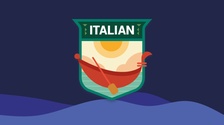寻找适合你的 英语 教师…
2675 人参与

#ItalianLeague
2675 人参与
Welcome to the Italian Language League! Meet other learners, get advice and motivation, and be part of the Italian learning community.
#ItalianLeague
Welcome to the Italian Language League! Meet other learners, get advice and motivation, and be part of the Italian learning community.
所有
展示更多
